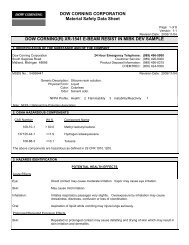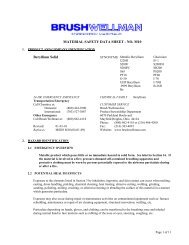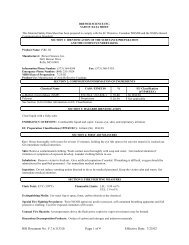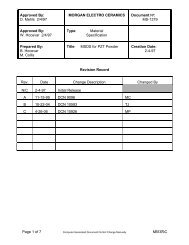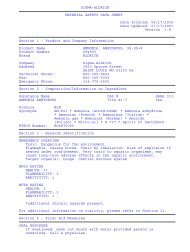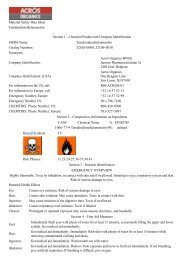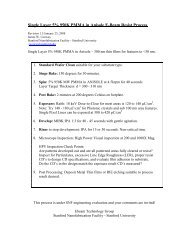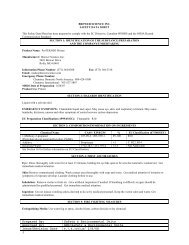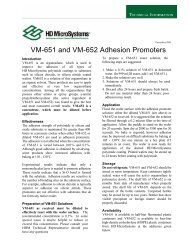EE 410 / Saraswat Handout #3 - Stanford Nanofabrication Facility
EE 410 / Saraswat Handout #3 - Stanford Nanofabrication Facility
EE 410 / Saraswat Handout #3 - Stanford Nanofabrication Facility
You also want an ePaper? Increase the reach of your titles
YUMPU automatically turns print PDFs into web optimized ePapers that Google loves.
<strong>EE</strong><strong>410</strong> / <strong>Saraswat</strong> <strong>Handout</strong> <strong>#3</strong><br />
area, resolution required), and the substrate (reflectivity, film quality, patterns). In general, the<br />
3612 resist has a broad process window, relative to the feature size in the <strong>EE</strong><strong>410</strong> device.<br />
• Use T1 for a focus/exposure matrix (FEM). To get a proper feel for overand underexposure,<br />
it is useful to run a fairly broad exposure range on the test wafer.<br />
• Note: An exposure in the range of 60-90 mJ/cm2 on the asml is probably reasonable.<br />
Unless you are really trying to expose very small features, it is usually best to over-expose<br />
the wafers a bit. It is frustrating to realize that one or two of the wafers have scumming and<br />
need to be stripped, re-coated with resist, etc.<br />
• Determine the proper exposure level by inspecting the test wafer under the microscope. At<br />
the lower exposure levels, you will see evidence of resist remaining in open field regions,<br />
which needs to be avoided. Even when you think that there is no "scumming" of this type,<br />
there can be residual resist in some areas. Scumming should be mostly gone by using an<br />
exposure setting of 60-90 mJ/cm2. If the process is marginal, normal wafer-to-wafer<br />
variation which may yield slightly different oxide thickness or slightly different resist<br />
thickness might result in scumming on another wafer, even at the same machine settings.<br />
At the highest levels of exposure, you should begin to see evidence of rounded features<br />
particularly if you look at the Vernier structures that contain two rectangles that are just<br />
touching at adjacent corners. After exposing wafer T1, you may want to expose another<br />
wafer at your selected setting (or a narrower exposure matrix) to confirm that everything is<br />
alright.<br />
• We often skip this step because the needed exposure is often known from experience. If in<br />
doubt, a matrix may be run, and this should be noted in your runsheets. However, wafer T<br />
is still a good test of the expected exposure.<br />
The litho process steps are:<br />
• Singe & Prime in the yes<br />
• Spin coat using svgcoat/2 programs 9 (no prime), 7 (1.0 µm of 3612 resist w/2 mm EBR),<br />
and 1 (prebake 90 C for 60").<br />
• Expose on the asml<br />
Job name: <strong>EE</strong><strong>410</strong>R_1<br />
Layer ID: 1<br />
Layer Number: ACTIVE<br />
Image ID: ACTIVE<br />
Reticle ID: <strong>EE</strong><strong>410</strong>RET1<br />
• Post-exposure bake on svgdev/2 using programs 9 (no develop) and 1 (post-exposure<br />
bake@110º C for 60").<br />
• Resist develop on svgdev using programs 3 (develop) and 1 (postbake@110º C for 60")<br />
• Inspect and rework as necessary.<br />
7. Active Area Etch (STEPS 1.200-1.240):<br />
FOX etch is performed wet so that the oxide step is gentle. This helps avoid poly stringers and<br />
improves metal step coverage. The profile is not simply isotropic but is sloped because the oxide<br />
etches slightly faster at the resist boundary. Be careful with this— a change of resist or of<br />
procedure could alter the profile. This has been tested with the 3612 and 1813 resists. This etch<br />
may also vary in length from about 400 to 600 seconds, it is a good idea to use fresh BOE.<br />
Revised Jan. 11, 2008 Page 17/47



